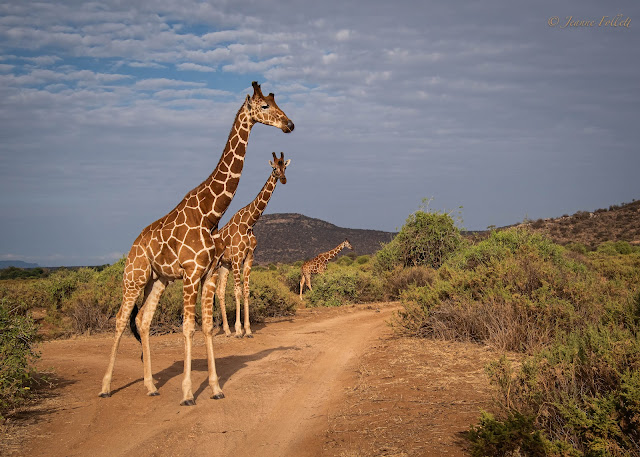(TO VIEW THE PHOTOS IN THEIR BEST RESOLUTION, CLICK ON ONE. THAT OPENS A FILM STRIP TGHAT YOU CAN BROWSE THROUGH.)
I recently responded to a post on Facebook by long time friend and photographer Eberhard Brunner, who was telling of his travels through Africa in 1973.
In the story, he was heading to an area in northern Kenya called Samburu, and told of warnings from locals about the dangers there from roaming Somalis.
In response to my comment, he asked if I’d ever been to Samburu. So, I went into my 2021 photo archives and dug out some photos to show him.
Samburu National Reserve is home to five “rare” species, few of which are found elsewhere: the reticulated giraffe, Beisa oryx, gerenuk, Grevy’s zebra, and Somali ostrich.
I thought I’d share the photos with you, along with some information about them.
The reticulated giraffe:
Giraffes are the tallest land mammal on earth, though the reticulated is the smallest of the nine varieties at 15 to 18 feet high, with a body length of 12 to 15 feet. Males can weigh up to 3000 lbs., and females about 1500 lbs.
Their rich auburn polygon patches are offset by striking cream-colored lines, with each giraffe having a pattern unique to itself.
The Beisa oryx is considered near threatened due to its declining population. Lions, leopards, and cheetahs are the main predators of these medium-sized antelope. Their ringed horns are thin and straight and grown by both sexes. Some males have been known to grow horns up to four feet, though more common are those in the 30 inch length.
Both males and females have the same striking colors.
More closely related to the wild ass, the Grevy’s zebra is taller than its cousins, the plains zerba, which are more related to the horse. They have longer legs and larger ears, as well as narrower stripes.
 |
| Reticulated giraffe and Grevy's zebra. |
The population of Grevy’s zerbras has declined 54 per cent in the last three decades, with an estimate only 2000 left. When I was at Samburu, the country was experiencing an extreme drought and wildlife personnel were providing hay for the zebra. There was plenty of water to drink, but not enough rainfall to grow the grass these herbivores favor.
The Gerenuk. What an unusual animal. In Somali, the word gerenuk means giraffe-necked and it is so appropriate. Another unusual trait of this antelope is its ability to stand on its hind leg and eat leaves from bushes.
Habitat loss has reduced to gerenuk population to near-threatened.
Somewhat smaller than the common ostrich, the Somali ostrich is unique in that its skin of pale blue-gray. During breeding season, the neck of the common ostrich becomes red which the Somali becomes bright blue. This ostrich has a wide range across several countries.
 |
| This little calf is sticking out its trunk to smell us. |
 |
| A leopard in thick brush close to nightfall. My camera ISO was at 12800! |
 |
| The prettiest of all the guineaufowl, from the neck down at least, is the Vulturine guineafowl, so called because its head resembles that of a vulture. |
 |
| Beautiful bird. |














You betcha Gullible! We sure enjoyed your revisit to The Samburu National Reserve from your 2021 Africa Journals. Many, if not all, of the photos sure looked familiar to us. Great re-visit Gullible. Cap and Patti
ReplyDelete